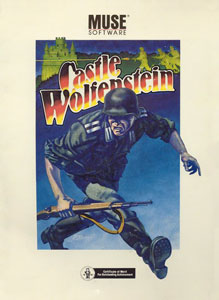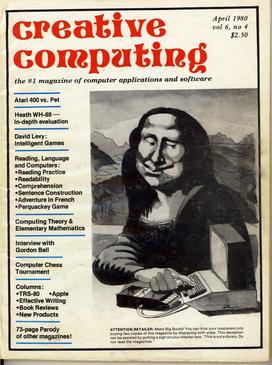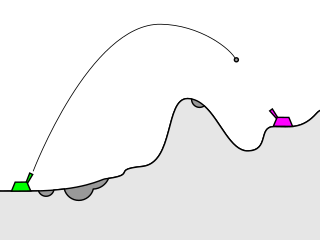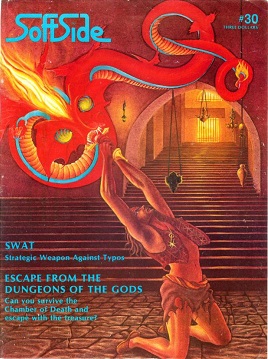
The Apple II series of microcomputers was initially designed by Steve Wozniak, manufactured by Apple Computer, and launched in 1977 with the Apple II model that gave the series its name. It was followed by the Apple II Plus, Apple IIe, Apple IIc, and Apple IIc Plus, with the 1983 IIe being the most popular. The name is trademarked with square brackets as Apple ][, then, beginning with the IIe, as Apple //. In terms of ease of use, features, and expandability, the Apple II was a major advancement over its predecessor, the Apple I, a limited-production bare circuit board computer for electronics hobbyists.

The Apple II a personal computer released by Apple Inc. in June 1977. It was one of the first successful mass-produced microcomputer products and is widely regarded as one of the most important personal computers of all time due to its role in popularizing home computing and influencing later software development.

The VIC-20 is an 8-bit home computer that was sold by Commodore Business Machines. The VIC-20 was announced in 1980, roughly three years after Commodore's first personal computer, the PET. The VIC-20 was the first computer of any description to sell one million units. It was described as "one of the first anti-spectatorial, non-esoteric computers by design...no longer relegated to hobbyist/enthusiasts or those with money, the computer Commodore developed was the computer of the future."

Archon: The Light and the Dark is a 1983 video game developed by Free Fall Associates and one of the first five games published by Electronic Arts. It is superficially similar to chess, in that it takes place on a board with alternating black and white squares, but instead of fixed rules when landing on another player's piece, an arcade-style fight takes place to determine the victor, and each piece has different combat abilities. The health of the player's piece is enhanced when landing on a square of one's own color.

Castle Wolfenstein is a 1981 action-adventure game developed by Silas Warner for the Apple II and published by Muse Software in 1981. It is one of the earliest games based on stealth mechanics. A port to Atari 8-bit computers was released in 1982, followed by Commodore 64 (1983) and MS-DOS (1984).
Micro Users Software Exchange, Inc., doing business as Muse Software, was an American video game developer based in Baltimore, Maryland, focusing on the development of games for the first generation of home computers. The company began with developing games for Apple II, and later expanded to the Commodore 64, Atari 8-bit computers, and IBM PC compatibles. They are best known for creating the Wolfenstein series, having developed the first two installments: 1981's Castle Wolfenstein and its 1984 sequel, Beyond Castle Wolfenstein. The brand name lapsed and was used by id Software.

Star Trek is a text-based strategy video game based on the Star Trek television series (1966–69) and originally released in 1971. In the game, the player commands the USS Enterprise on a mission to hunt down and destroy an invading fleet of Klingon warships. The player travels through the 64 quadrants of the galaxy to attack enemy ships with phasers and photon torpedoes in turn-based battles and refuel at starbases. The goal is to eliminate all enemies within a random time limit.

Bill Budge is a retired American video game programmer and designer. He is best known for the Apple II games Raster Blaster (1981) and Pinball Construction Set (1983).

Creative Computing was one of the earliest magazines covering the microcomputer revolution. Published from October 1974 until December 1985, the magazine covered the spectrum of hobbyist/home/personal computing in a more accessible format than the rather technically oriented Byte.
Crobots is a programming game released for the first time by Tom Poindexter in December, 1985 as Shareware. It is an MS-DOS program for IBM PC and compatibles and was developed on x86-based Unix systems.
Turn-based tactics (TBT) is a video game genre of strategy video games. They are turn-based simulations of operational warfare and military tactics in generally small-scale confrontations as opposed to more strategic considerations of turn-based strategy (TBS) games. Turn-based tactical gameplay is characterized by the expectation of players to complete their tasks using only the combat forces provided to them in a generally realistic manner.

Computer Bismarck is a computer wargame developed and published by Strategic Simulations, Inc. (SSI) in 1980. The game is based on the last battle of the battleship Bismarck, in which British Armed Forces pursue the German Bismarck in 1941. It is SSI's first game, and features turn-based gameplay and two-dimensional graphics.

Artillery games are two or three-player video games involving tanks trying to destroy each other. The core mechanics of the gameplay is almost always to aim at the opponent(s) following a ballistic trajectory. Artillery games are among the earliest computer games developed; the theme of such games is an extension of the original uses of computer themselves, which were once used to calculate the trajectories of rockets and other related military-based calculations. Artillery games have been described as a type of "shooting game", though they are more often classified as a type of strategy video game.
The ZX Spectrum's software library was very diverse. While the majority of the software produced for the system was video games, others included programming language implementations, Sinclair BASIC extensions, databases, word processors, spread sheets, drawing and painting tools, and 3D modelling tools.

SoftSide is a defunct computer magazine, begun in October 1978 by Roger Robitaille and published by SoftSide Publications of Milford, New Hampshire.

Many games, utilities, and educational programs were available for Atari 8-bit computers. Atari, Inc. was primarily the publisher following the launch of the Atari 400/800 in 1979, then increasingly by third parties. Atari also distributed "user written" software through the Atari Program Exchange from 1981 to 1984. After APX folded, many titles were picked up by Antic Software.

Robot Battle is a programming game developed in 1991 by Blue Cow Software for the Apple Macintosh where players design and code adaptable battling robots. Its idea is similar to RobotWar. The concept of the game was invented by Toby Smith in a BASIC program "when people with 512K of RAM and two floppy drives were power-users", as he states in the game manual.

Gorgon is a clone of the arcade game Defender, a horizontally-scrolling shooter, for the Apple II. It was programmed by Nasir Gebelli and published by Sirius Software in June 1981.
Color Robot Battle is a programming game developed by Glenn Sogge and Del Ogren for the TRS-80 Color Computer and published by Radio Shack in 1981.














